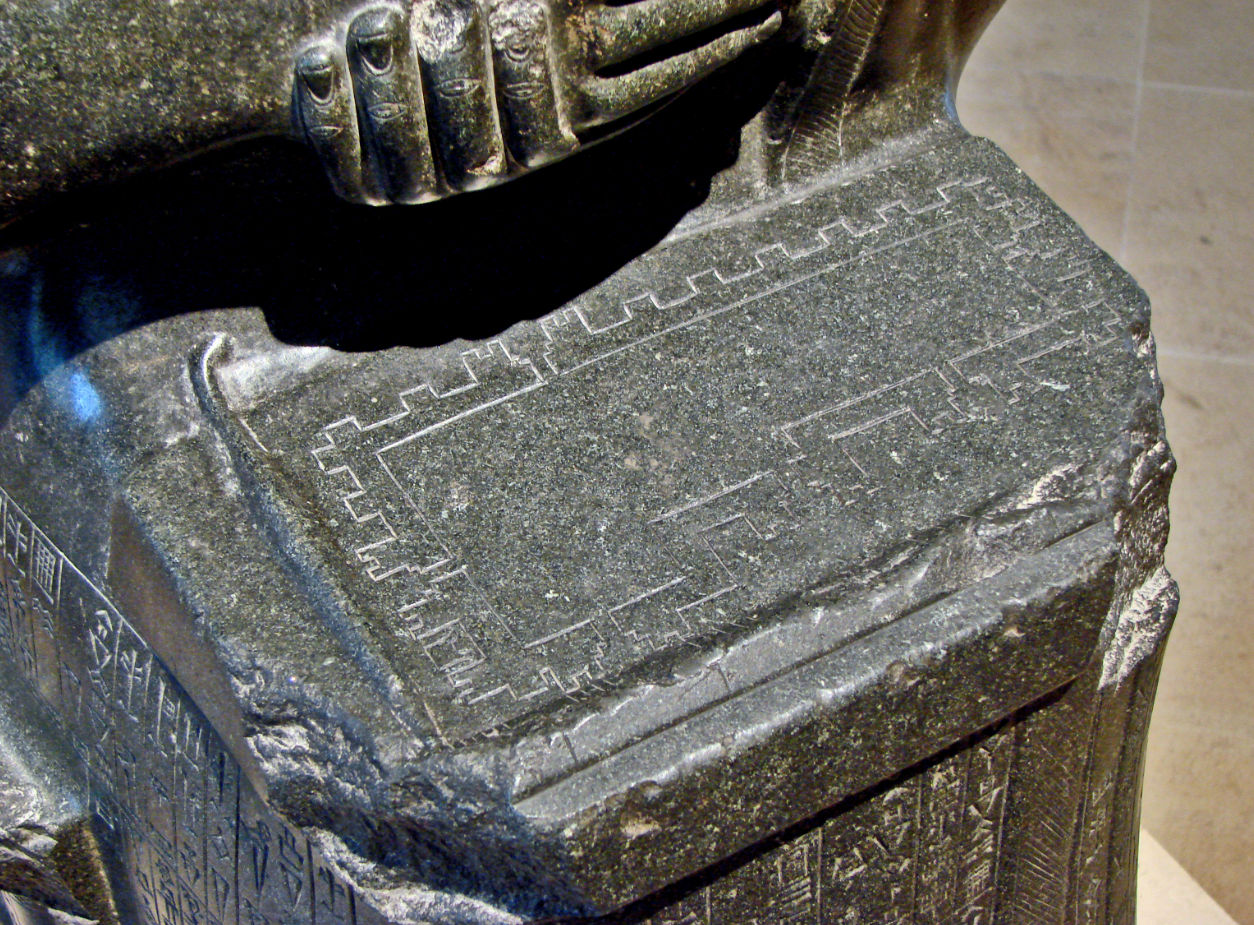The earliest known rising sun deity can be earliest traced to the Sumerian city state of Lagash around 2200 B.C. Lagash was in eastern Sumer near Susa, which was a proto-iranian city state located at the base of the Zagros mountains, in a region of modern day Iran the historians call Elam.
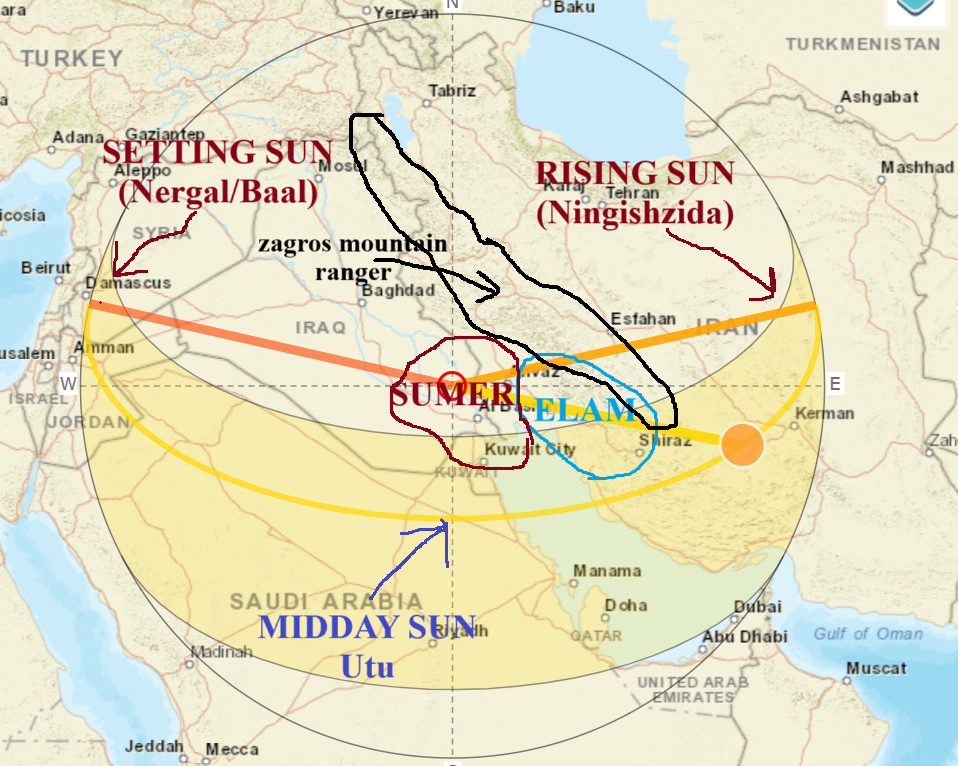
The old boys of Oxford would deny this, but it seems their precious Akkadian empire had actually been defeated militarily by an Elamite ruler named Inshushinnak from Susa, who must have been allied with the ruling dynasty in Lagash, as Lagash promptly entered into a golden age after the collapse of Akkadian hegemony based on trade coming in through Elam to the east.
This is probably why the ruling dynasties of Lagash were omitted from the Sumerian Kings List, written in the following millennium by Babylonian scribes using the Akkadian writing script.
However, despite Babylonian efforts to omit Lagash from the history books, French archaeologists necromanced the legacy of Lagashian dynasties back from the dead when they stumbled upon the city’s ruins in the late 19th century.
Before we continue, it’s important to understand Mesopotamian mythology has been mostly pieced together into what are called composite texts. These are compositions of tablet fragments founds all over the region from different periods and civilisations, pieced together at the discretion of mostly scholars from Oxford University or the University of Pennsylvania.
This isn't to say composite texts can't be trusted. Only that they aren't genuine factual artefacts. Which is to say they aren't authoriative. They are like missing scenes of a classic film filled with those of its remake. And we all know how far remakes stray from originals.
Now, all mesopotamian mythology you've heard of that dates prior to 2000 B.C is to different varying degrees composite text, with one exception. In Lagash French excavations found two almost perfectly preserved cylinder texts containing a myth called, ‘The Building of Ningirsu’s Temple’. Which outlines the construction of a temple by a Lagashian ruler named Gudea for the city's patron deity Ningirsu.
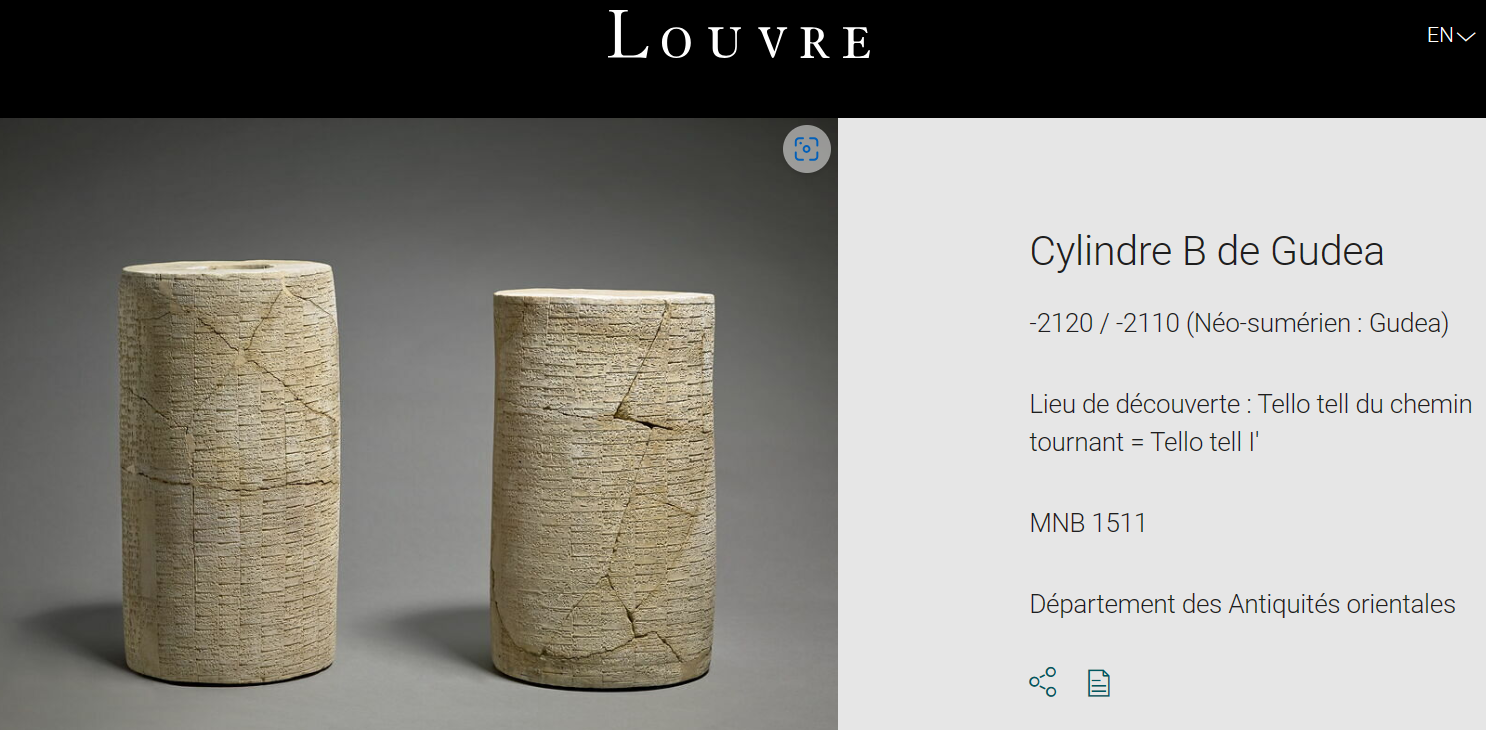
https://collections.louvre.fr/en/ark:/53355/cl010124630
According to the cylinder texts, which are as it currently stands, the oldest genuine written religious texts in history, the Lagashian ruler Gudea receives the designs for a sacred temple in a revelation from a sumerian goddess of writing named Nisaba, who shares with him the "inmost secret of numbers".
This makes Gudea the first religious prophet in known history, but also a real historical figure too. See, Gudea wisely had statues of himself carved in hard blackstone slabs of diorite, and this cooled magma spewed up through mountains from the underworld has preserved his image well through the millennia. Along with one other detail.
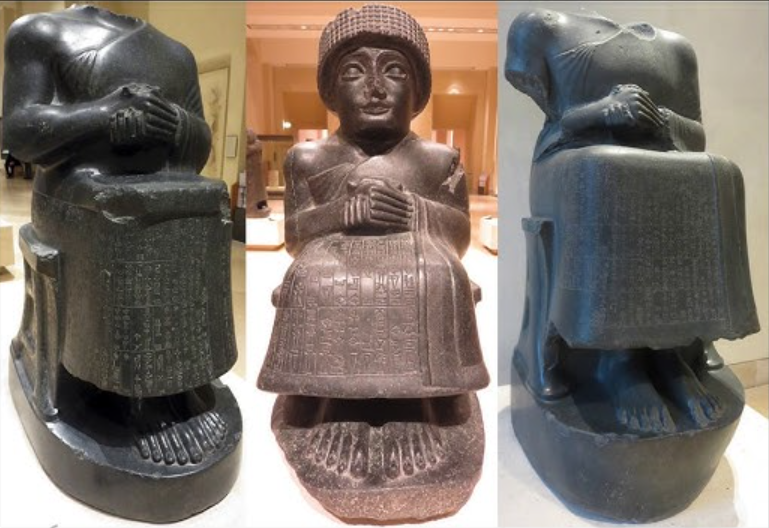
In one of these, Gudea can been seen with a tablet in his lap, marked with the blueprints for a temple. And the units of measurement in the blueprint match those for the ruins of a temple to Ningirsu discovered in Lagash aswell.1
The political implications of this are profound and difficult to fathom. Further intensified by a religious resurgence we seem to be entering into, a yearning for some kind of 21st century solution to meet the spiritual needs inadequately unattended to by psychologists and psychiatrists in the 20th. See, what the atheists couldn’t understand is that people have a need to understand things that can’t be known. And things that can’t be known cannot be dealt with as knowledge. Which is to say, spirituality cannot be dealt with in facts, only in faith.
This is why those who try to make science their religion will always fail. They will keep having to change their prime mover because knowledge is flux, and thus perpetually undermines the legitimacy for static answers. Silly atheists, didn’t you know, anything spiritual which can be known, is simply moved over from the spiritual to the scientific, that is in real terms, from the metaphysical to the physical. That is literally the scientific process. The two are not in contradiction and never have been, except to idiots or the nefarious. As god can always remain one step ahead as the prime mover behind the knowledge we discover about the physical world.
In real political terms, the implications of the Lagash discoveries center around their use as evidence for shifting the historical origins of the Abrahamic religions, away from their current semetic pagan roots in ancient Babylon, further east into modern day Iran.
If you think none of this matters, or is of little political consequence to the present and future, consider the geopolitical activity in the archaeological regions of concern here, namely Turkey, Iraq, and Iran; then consider which items from these regions western oligarchs have coveted, collected, and kept in private collections like new money do sports cars.
The name Ningishzida was found inscribed on a libation vase in a dedication by Gudea to his personal deity. Alongside the inscription is also found the earliest known proper representation of the caduceus. A sophisticated philosophical symbol of two-snakes entwined around a pole or staff, which later became a scepter symbolizing a ruler’s divinity as the link between metaphysical and physical worlds(middleman between gods and men).
The caduceus is different from the ubiquitous symbol of snakes coupling found elsewhere, as the inclusion of the pole or staff, or really polestar, is a unique early representation of the tree of life. This is thought by some to be the meaning of the name Ningishzida: Lord of the Good Tree.

https://collections.louvre.fr/en/ark:/53355/cl010143800
Not long after this was discovered the caduceus found its way onto the metal work of the bank of england, alongside the divine twins Lugalirra and Meslamtaea(proto-nergal).

Caduceus doors

Divine Twins door.
A further association of Ningishzida and snakes is seen on Gudea’s administrative seal. In the scene, Ningishzida is depicted with snakes peeking over his shoulders, leading Gudea by the hand to an audience with a god, probably Ningirsu(god of the mountain).
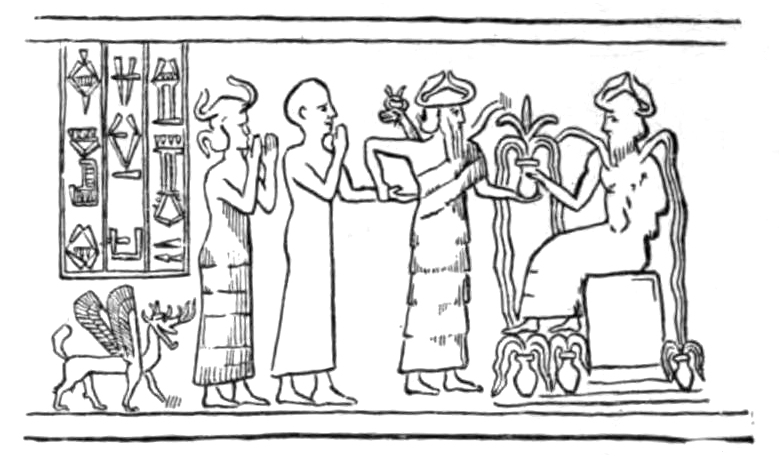
This first aspect of Ningishzida is as chthonic snake god, the origins of which are probably found somewhere in the Zagros mountain range, so Iran, as part of a pantheon of gods loosely referred to by interested academics as trans-tigridian snake gods. The second aspect of Ningishzida was as the rising sun, symbolizing his return from the underworld, probably to deliver judgments from the anunnaki gods - who were a sort of mythological supreme court of justice in the underworld, made up of various former gods who'd been removed from circulation and relegated there for various political reasons, but kept relevant in this detached sort of way to legitimize political actions. Ningishzida is expressly referenced as a rising sun, or perhaps the light of the rising sun, by Gudea himself in the cylinder texts, which he had surely commissioned:
"132-133:The daylight that had risen for you on the horizon is your personal god Ningiczida, who will rise for you as the daylight on the horizon."
- The building of Ningirsu´s temple: translation, The Electronic Text Corpus of Sumerian Literature
“Gudea has a dream which he asks the goddess NinA to interpret. She tells him that he has seen the supreme god, of colossal size, Ningirsu, crowned and with the sacred eagle, Im-gig, in his hand, the storm-wind at his feet and a lion crouching on either side: also a woman with a tablet and a man marking the plan of a temple on another tablet, showing that he should build a temple to Ningirsu. Then came a figure representing the rising sun, which the goddess identifies--after naming the others-as Ningishzida, saying: "The Sun which lifted itself up from the earth before thee, is thy god Ningishzida. Like the Sun he goes forth from the earth."
- Babylonian Origin of Hermes the Snake-God, and of the Caduceus I, A. L. Frothingham, American Journal of Archaeology , Apr. - Jun., 1916, Vol. 20, No. 2 (Apr. -
Jun., 1916), pp. 175-211
So by 2100 B.C there is hard archaeological evidence for the following:
1. A prophet ruler named Gudea who receives a divine revelation to construct a sacred temple.
2. The sacred designs for this temple provided by a goddess of sacred geometry named Nisaba who "knows the inmost secret of numbers"
3. A deity named Ningishzida that is both the aspect of a chthonic serpent and rising sun.
4. A god named Ningirsu who Gudea constructs this sacred temple to.
According to Gudea's cylinder texts, Ningirsu was born from a mountain and associated with an earth mother goddess named Ninhursag, the lady of the sacred mountain.
207-216: He rose to his master in public and prayed to him; he went to him in the Ubcukkina and saluted him: ´My master Nin-jirsu, lord who has turned back the fierce waters, true lord, semen ejaculated by the Great Mountain, noble young hero who has no opponent, Nin-jirsu; I am going to build up your house for you, but I lack an ominous sign. Warrior, you asked for perfection, but, son of Enlil, lord Nin-jirsu, you did not let me know your will as to how to achieve it.
- The building of Ningirsu´s temple: translation, The Electronic Text Corpus of Sumerian Literature
This mythological pantheon then bleed into the Neo-Sumerian Ur Dynasty III(2100-2000B.C), whose first two rulers Ur-Namma and Shulgi reference Gudea's personal deity Ningishzida in praise poetry. Ur III was the final Sumerian ruling dynasty of mesopotamia, that sparked a neo-sumerian renaissance from which we trace the Gilgamesh myths.
These myths are a series of kingship origin stories that come to us as composite texts derived from tablets found mostly in the ruins of scribal schools in Nippur, an ancient mesopotamian religious center, dated from between 2000-1700 B.C. These same scribal schools are the ones which had omitted the Lagashian king dynasties from their records.
The gilgamesh myths shift the origin of mesopotamian mythology away from Lagash, to a dubious dynasty of kings from Uruk, which begins with Gilgamesh’s father Lugalbanda, who features in a myth from this series called ‘Lugalbanda in the mountain cave’.
In it, Lugalbanda journeys from Uruk into the Zagros mountains, towards a place called Aratta. Along the way he is stricken ill and taken by his compatriots into a mountain cave. There he lies dying for several days with an iron dagger clutched to his chest. Here he receives a vision, or perhaps fever dream, from a god named Zangara(probably the origin of the greek morpheus), a god of dreams, who tells him to use the iron dagger to sacrifice a bull to the rising sun, and a goat to the snake of the mountain. Lugalbanda follows these instructions and as a result is resurrected/gets better. A common theme of early mythology is didactic prophesy, that is, stories designed to preach the benefits of following the specific detailed instructions laid out in a ruler's devine visions.
"351-360: Who will slaughter (?) a brown wild bull for me? Who will make its fat melt for me? He shall take my axe whose metal is tin, he shall wield my dagger which is of iron. Like an athlete I shall let him bring away the brown wild bull, the wild bull of the mountains, I shall let him like a wrestler make it submit. Its strength will leave it. When he offers it before the rising sun, let him heap up like barleycorns the heads of the brown goat and the nanny goat, both the goats; when he has poured out their blood in the pit -- let their smell waft out in the desert so that the alert snakes of the mountains will sniff it."
- Lugalbanda in the mountain cave: translation, The Electronic Text Corpus of Sumerian Literature
“361-370 :Lugalbanda awoke -- it was a dream. He shivered -- it was sleep. He rubbed his eyes, he was overawed. He took his axe whose metal was tin, he wielded his dagger which was of iron. Like an athlete he brought away the brown wild bull, the wild bull of the mountains, like a wrestler he made it submit. Its strength left it. He offered it before the rising sun. He heaped up like barleycorns the heads of the brown goat and the nanny goat, both of the goats. He poured out their blood in the pit so that their smell wafted out in the desert. The alert snakes of the mountains sniffed it.”
- Lugalbanda in the mountain cave: translation, The Electronic Text Corpus of Sumerian Literature
Either the ancient language scholars at Oxford are up to something devious, or this would be the oldest known origin for bull and goat slaughtering rituals performed by mystery cults of elite society throughout classical antiquity, right through until they manifest in the mithraic rites of the Julio-Claudian dynasty of Rome, when these cults started to underground. . .literally i might add.
The truly eyebrow raising part of this text is its reference to an iron dagger. Historians date the myth to around 2500-2200 bc in origin, and archaeologist the tablet the text is recorded on to around 1800 bc. However, the advent of the iron age isn't until around 1300 b.c, and nor is iron weaponry even conventional until a few hundred years after that. Which would mean the iron in question is most likely meteoric. Or what the Sumerians called An.Bar - ‘fire from heaven’.
112-114: They wrapped up by his chest his dagger of iron imported from the Gig (Black) mountains.
112: saj-ja2-ni-ce3 im-ci-ib-ru-gu2-ne,
113: jiri2 ur2-ra-ka-ni an-bar-sug4-ga-am3
114: hur-saj gig2-ta cu-a bal-a
- Lugalbanda in the mountain cave: translation
When a meteor passes through earth’s atmosphere, the windspeed fans the bright streak of its flames to temperatures high enough to smelt any iron ore into a quasi-steel called meteoric iron, which looks like this.

An actual dagger made of meteoric iron was found in a tomb within the Royal Cemetery of Ur, where the ancestors of Ur Dynasty III had been buried around 2500 B.C. And on the cylinder seal of the first ruler of their first dynasty, Mesannepada of Ur Dynasty I, is a human swastika made of men armed with daggers.
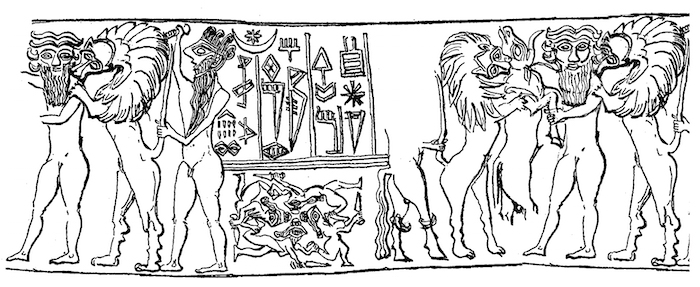
Mesannepada King Seal, 2500ish B.C
Another meteoric iron dagger has also been found within Royal Tombs of the proto-Hittie people of Anatolia, dated to the exact same period of around 2500 B.C.

meteoric iron dagger recovered from Alaca Höyük, museum of anatolian civilisations, ankara, turkey.
Meteoric iron was not only of religious interest, but hinted in a sort of prophetic way at a future technology which would bring about a new age. Iron. It stands to reason that the first smithing guilds to crack the temperatures required of iron smelting had made the connection between the flames of a meteor being blown at highspeed and the need for somekind of bellows technology to replicate this. It's not difficult to imagine how these objects became idols of worship. If the planets were gods, then meteors were fallen gods, like prometheus, who stole fire from the gods to give to man.
An.Bar - Fire from heaven
Terrestrial iron appears to have first been mass produced in Anatolia during early to middle second millennium by the Hittites, who used their weapons advantage to blitz south-east along the fertile crescent in chariots to eventually sack Babylon around 1600, thus ending Amorite hegemony in the region, and along with it, the imperial power of astrology priesthoods.
The Hittites seem to have kept iron smelting a secret for a number of centuries before it became mainstream. Thus the method itself probably dates back much earlier than the given advent, and was kept secret through fraternal orders of intiation developed by a new rising industrial power of metallurgy guilds. As Quigley the historian explains:
“Although we must emphasize that many peoples in many places contributed to the knowledge of steelmaking, in the West the greatest contributions came from Armenia and from Noricum (Carinthia) in central Europe. We have already said that the origin of agriculture and of metal working are to be sought in the hilly zone where Anatolia is attached to Asia along the line from Alexandretta Gulf north to the Black Sea near the Caucasus Mountains. The beginnings of our kind of agriculture may lie near the southern end of this line, south of Lake Van; the early history of copper and bronze seems to lie on the same line but probably north of Lake Van, while the vital steps in the western use of iron seem to have happened even farther north, in Armenia itself. There, it would seem, the smelting of iron from its ores goes back to about 2000 B.C., and the carburizing of the resulting wrought iron was advancing by 1500 B.C. At that time the nearest civilised society was the Hittite, and it may be that the Hittite government tried to keep the developing innovation secret for some centuries. This would not be so difficult as we might imagine, for not only was the technique a difficult one that only an experienced metallurgist could understand, but the metal workers of this region had been very secretive about their earlier skills in copper metallurgy so that they could obtain high pay for the use of their skills, selling their products but not allowing their methods to be known. In fact, the early history of metallurgy is full of wandering groups or guilds of such workers who moved about, filling orders as they obtained them, and then moving on, with the tools of their trade on pack animals and the secrets of their skills kept locked in their heads, to be passed on only to their sons or apprentices.”
- ‘Weapon Systems and Political Stability, Caroll Quigley
During this same period in the second millennium, mesopotamian mythology, featuring a pantheon of Sumerian gods since modified by babylonian astrology, started to spread north-west in the other direction, back along the fertile crescent, up into Anatolia via Syria, where it mixed in with Hurrian(proto-Hittite) gods to create a hybrid Hittite pantheon of myths, from which we start to get written records from around 1300 BC.
From these myths, which historians call ‘the Kumarbi cycle’, come the earliest known references to a connection between gods and sacred stones, sometimes called huwasi stones. The worship of these divine rocks, which were probably meteors, likely represented a shift in religious power from the old astrology priesthoods of mesopotamia, whose pantheon had been pegged to planets, towards a new order of indo-european metallurgy guilds in Anatolia, whose specialised knowledge from their study of rocks and engineering became the driver behind the iron age invasions.
The rivalry between the established religious power of the priesthoods and the rising industrial power of the metallurgy guilds probably serves as the real world inspiration for the clash between olympians and titans in greek myth. The titans being a new industrial power, engineering new technology that disrupts the established religious order of the olympians, whose armies could no longer uphold the legitimacy of its organising principle. which would be why modern day "titans of industry" are in keeping with this tradition by idolizing titans such as atlas, but especially prometheus. And this is also probably why the Rockefeller family named their two legacy financial institutions: Blackstone and BlackRock.
In a Hittie myth called 'Song of Kumarbi', dated around 1400-1200 b.c, a Hurrian god named Kumarbi usurps power from the Sumerian skygod Anu and bites off his genitals. Kumarbi manages to spit some of Anu’s semen into a mountain which gives birth to a god named Tasminu. Some of Anu’s semen that Kumarbi accidentally swallowed impregnates him with a storm god named Teshub, who is born from a split opening in Kumarbi’s skull. Kumarbi attempts to devour Teshub, but is tricked into eating a stone instead. Teshub grows strong and powerful and overthrows his father Kumarbi. Kumarbi then fucks a great rock(probably some proto-mountain goddess Cybele) who gives birth to a meteoric iron blade named Ullikummi, who Kumarbi sends to earth to be safely raised as an adversary against Teshub. Ullikummi grows powerful enough on earth to reach heaven, overthrowing Teshub’s regime under which the two had been separated(dualistic). Industrial titans vs Theological Olympians.
The Titans want heaven and earth united, the Olympians want it separated. The meteor is literally speaking, and I mean in actuality as a real artefact with observable motion, the link between heaven and earth, or above and below, or terrestrial and extraterrestrial, the earth and the planets.
This is what became Greek Myth. Kumarbi is Kronos(Saturn). Teshub is Zeus(Jupiter). And Ullikummi is Prometheus(The Meteor).
Hittite civilisation turned into the Phrygian kingdom around 1200 B.C, and these myths spread into Greece via the Ionian and Dorian migrations, primarily the orphic mysteries spread by the cults of Apollo and Dionysus. Then centuries later they spread into Rome via the phrygian cults of Cybele and Sabazios, and then later the Syrian cult of Sol Invictus Elagabulus. All five of these cults concern the worship of meteors, by that time also known as baetylus, or blackstones.
I will explain precisely how all this occured in part 3.
